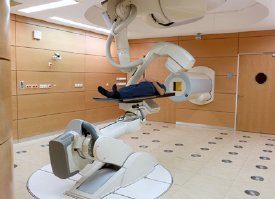Mar 19 2008
Today the University Clinic of Schleswig-Holstein (UC S-H) commissioned a consortium of bidders including Siemens, Bilfinger Berger and HSG Technischer Service with the construction and operation of the first particle therapy center (PTC) in Northern Germany.

With overall costs of roughly 250 million EUR, this represents the largest public private partnership (PPP) project ever launched in the German healthcare sector. As a competence center for tumor diseases, the PTC will be opening up new treatment possibilities for cancer therapy starting in 2012. In addition to Northern Germany, the center is intended to serve the entire Southern Scandinavian region. In its final stage of completion, the facility's three treatment rooms will be capable of treating approximately 3000 patients with particles per year.
The contract concluded between the consortium of bidders and the UC S-H includes the planning, construction, financing, technical operation, and maintenance of the particle therapy facility in a public private partnership over a period of 25 years. To implement this project, the sponsors Siemens Project Ventures and Bilfinger Berger Project Investments established a project company which will be refinanced via an international group of banks. In addition to the facilities for applying particle therapy (PT), the PTC will also include a department for conventional radiation therapy. Conventional radiation therapy is planned to begin at the end of 2011, and the PT facility should be started up at the beginning of 2012.
"The Kiel PTC represents a milestone for medical engineering solutions and partnership models in oncology. The Competence Center for Radiotherapeutic Oncology in Kiel will set the trend for additional particle therapy centers in Europe and the United States", emphasized Prof. Dr. Erich R. Reinhardt, CEO of the Siemens Healthcare Sector.
Siemens will provide planning and installation of the Particle Therapy System. The scope of deliverables includes medical imaging and information systems as well as the associated maintenance and technical operation. Bilfinger Berger Hochbau will be responsible for the turnkey construction of the center. The Hamburg branch will complete the building with four overground stories and two underground stories within 24 months. For this project, Bilfinger Berger can rely on their expertise gained with projects for the healthcare sector. HSG will be responsible for the technical and infrastructural building management including maintenance and reinvestment of the technical and structural facilities and the outdoor area. Furthermore, HSG will ensure the required power, heat and water quantities for the building with the exception of the medical facilities. In cooperation with Bilfinger Berger Project Investments, Siemens will also bring its expertise in infrastructure projects into the partnership via the Siemens Project Ventures GmbH (SPV). SPV and Bilfinger Berger Project Investments will each contribute 50 percent of the required equity capital.
"The participation of private financing partners plays a decisive role in the implementation of complex public infrastructure projects", said Wolfgang Bischoff, Managing Director of Siemens Project Ventures GmbH. "This type of PPP solution is increasingly becoming the ¡®standard model¡¯ for general cooperation between the public and private sectors, and not just in healthcare." With this project, Bilfinger Berger is extending its private-enterprise operator business to include the German healthcare sector. The company will contribute its extensive experience in financing, construction and building operation to the Kiel project.
Technological background of particle therapy:
In particle therapy, protons or carbon ions are accelerated to a very high speed by an accelerator system and then applied precisely to the target tissue. The particles cause largely irreparable damage to the tumor cells. Calculation and control with high precision enable more accurate irradiation of tumors than with previous techniques while avoiding unnecessary treatment of the surrounding healthy tissue. Due to its accuracy, this technique is especially suited for types of cancer which are difficult to access or located close to organs at risk, e.g. tumors located at the base of the skull or brain tumors. Other applications include soft tissue sarcomas and prostate carcinomas surrounded by sensitive tissue.
Approximately 50,000 patients have already been treated with particles worldwide. Of these, more than 3,000 have been treated with carbon ions. Only a combined system, which also enables the use of various ion types in addition to protons, can meet today's requirements for the efficient treatment of a broad range of tumors.
Posted March 19th,2008